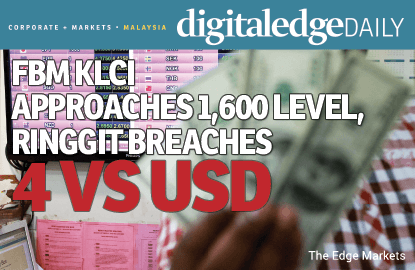
KUALA LUMPUR: The bears continue to swarm the stock markets, at home and in the region. Persistent selling resulted in a sea of red in Asian equity markets yesterday amid growing concerns about the macroeconomic outlook.
The FBM KLCI yesterday declined for its fifth consecutive trading day, inching its way to the 1,600-level. And the ringgit breached 4 against the US dollar yesterday, closing at 4.0275 against the greenback.
The benchmark index slipped 33.45 points or 2.04% during the day to an intraday low of 1,603.26 points. It managed to recoup some losses to close at 1,609.93 points — the lowest closing since February 2013, down 26.78 points or 1.64% yesterday. The FBM KLCI has tumbled 115.63 points or 6.7% for the past five trading days, from 1,725.56 points last Wednesday.
On the regional front, Indonesia led the fall with its Jakarta Composite Index sliding 3.1% to 4,479.49 points, and with the Singapore’s Straits Times Index losing 2.9% to 3,061.49 points. Japan’s Nikkei 225 fell 1.58% to 20,392.77 points, Hong Kong’s Hang Seng declined 2.26% to 23,916.02 points, while China’s Shanghai Composite Index was down 1.06% to 3,886.32 points.
China seems to be the party pooper. The country’s move to devalue its currency has sparked fears of a currency war, sapping investors’ risk appetite.
Rosnani Rasul, head of research at M&A Securities Sdn Bhd said the external factors, namely the devaluation of the yuan, the uncertainties surrounding the United States Federal Reserve rate rise, which is largely anticipated to be raised after the Federal Open Market Committee meeting next month, has further dampened the already weak local sentiment.
“The market is down not because of the exchange rate, but more on selling pressure due to the pessimistic macroeconomic outlook. Note that these foreign outflows are not something new, as we have noticed consistent selling since the second quarter of 2013,” she told the digitaledge DAILY.
According to her, foreign institutions have sold about RM13 billion in equities since 2013, which could mean that the selling pressure will recede soon.
“Although the selling pressure will ease, we are not expecting a sharp rebound so soon, as foreign investors are not expected to return to the local market anytime soon. We are expecting things to settle down within the next two years, which is when we are expecting foreign interest to return,” said Rosnani.
Asked on sectors that are worth watching for investment, she said the only sector to benefit from the weak currency would be glove makers, or select companies such as S P Setia Bhd (fundamental: 1.6; valuation: 2.0) which has earnings denominated in British pound due to its exposure to the United Kingdom market.
Meanwhile, she pointed out that the weakened ringgit will have a greater impact on companies with borrowings denominated in US dollar, such as Telekom Malaysia Bhd (fundamental: 1.1; valuation: 0.8) and Tenaga Nasional Bhd (fundamental: 1.3; valuation: 2.4).
“Companies with their input costs denominated in US dollar like UMW Holdings Bhd (fundamental: 1.8; valuation: 1.4), Tan Chong Motor Holdings Bhd (fundamental: 0.55; valuation: 1.4), and aviation companies would also see higher costs, but the impact on airlines could be neutralised by the low crude oil prices,” she said.
Jupiter Securities Sdn Bhd chief market strategist Benny Lee said the sentiment on the local market is generally bearish, and believes the momentum will continue in the short term.
“Most counters are in the red currently. Even the export-oriented counters which are expected to benefit from the stronger dollar, such as rubber glove makers and technology companies, are all seeing a correction,” he said.
“It’s really hard to pick stocks at this juncture due to the general bearish sentiment,” he said.
For the ringgit, Lee said there is still no support seen for the currency as it continues its decline on a daily basis. However, he expects some technical support at the 4.05 level.
Hong Leong Investment Bank Bhd (HLIB) had outlined stocks with exposure to China, in view of the currency devaluation move, which was seen as a measure to safeguard its economic growth.
The research house’s list includes Sime Darby Bhd (fundamental: 0.8; valuation: 1.4), as 24% of its revenue for FY14 was contributed by China, and OldTown Bhd (fundamental: 2.8; valuation: 1.1) which saw China contributing to 17% of its total fast-moving consumer goods (FMCG) sales in FY15.
Besides that, the research house also listed stocks such as AirAsia Bhd (fundamental: 0.2; valuation: 1.4) and Malaysia Airports Holdings Bhd (fundamental: 0.8; valuation: 2.0) which has exposure to Chinese tourists, and banking stocks such as CIMB Group Holdings Bhd (fundamental: 1.05; valuation: 2.25) and Malayan Banking Bhd (fundamental: 1.5; valuation: 2.25) which have operations in China.
“The percentage exposure varies but most, if not all, do not exceed 20% while some have less than 10%.
“The degree of impact could also vary, depending on type of business (that is whether defensive or cyclical), price competitiveness (weaker ringgit), availability of substitution, ticket item (big versus small) as well as ability of management to manoeuvre their strategy to minimise the impact,” said HLIB.
Despite the various exposures, HLIB said it is maintaining its assumptions and forecasts and is “not pressing the alarm bell yet”, as it expects the Chinese government to introduce more stimulus measures to sustain economic growth.

This article first appeared in digitaledge Daily, on August 13, 2015.